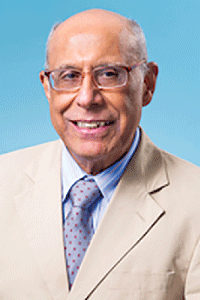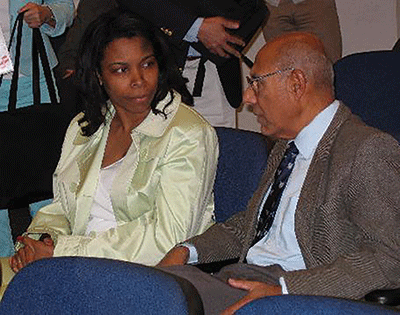Remembering Nozer Singpurwalla
Nozer Singpurwalla was a highly regarded statistician known for his influential contributions to the statistics field, particularly in reliability theory and risk analysis. Beyond his scholarly achievements, he is remembered as a mentor who had a profound commitment to the growth, development, and success of his mentees. He served as an adviser to more than 40 students.
His colleagues, family, and friends remember his sense of humor and willingness to engage in spirited conversations. Throughout his life, music, history, and travel with his family were his avocations.
He and his wife, Norah, had an “enchanted” introduction—meeting at a dance at Disneyland. They married in 1969 and were proud parents to Rachel and Darius.
After emigrating from India, Nozer began his academic career studying engineering at Rutgers University, earning an MS, and continued his studies at New York University, earning a PhD. His scholarly contributions include more than 200 publications and three books.
Nozer was a fellow of the Institute for Mathematical Science, American Statistical Association, and American Association for the Advancement of Science and an elected member of the International Statistical Institute.
His distinguished career included 40 years as a faculty member at The George Washington University, with appointments in both the department of statistics and operations research. He also served as a visiting professor at Carnegie Mellon University, Stanford University, the University of California at Berkeley, Florida State University, the Santa Fe Institute, and the University of Oxford. After his retirement from The George Washington University in 2013, he accepted a faculty appointment at the City University of Hong Kong and served in a variety of faculty roles until 2021.
Nozer’s scientific legacy will continue to inspire statisticians, researchers, and practitioners worldwide. His dedication as a mentor goes beyond imparting knowledge, so we are honored to share these remembrances demonstrating his lasting impact.
Sallie Keller, US Census Bureau
I first met Nozer in the mid-1990s, during my tenure as a National Science Foundation statistics program director. He turned into an extremely valuable resource for me on subjective probability and complex system assessment (aka Bayesian reliability theory and application). A few years later, when I was leading the statistical science group at Los Alamos, I needed to bring in an expert to help convince the weapons physicists and designers that Bayesian methods were mathematically sound and theoretically interpretable for their system assessments. Enter Nozer! We all learned together, even me. Nozer gave me a private lesson on the topic that has played a major role in how I have approached my work throughout my career. This was in the context of belief functions and fuzzy logic. He said, “Sallie, just because the math works doesn’t make it right!!” I miss Nozer’s wisdom and wit immensely.
Kimberly F. Sellers, North Carolina State University
Nozer Singpurwalla was my PhD adviser at The George Washington University, and I greatly valued his advice and mentorship—not only through the dissertation process but beyond that and throughout my career. Nozer was such a powerful force in statistics (particularly in reliability theory) and with that came a reputation of high demand and expectation from him. While that may make him sound like a daunting figure with whom to work, I valued working with him all the more because he demanded the same level of excellence from me that I demanded of myself.
In the spirit of “Nozer knows,” he was a wealth of knowledge, not only regarding research and the discipline, but also how to navigate and excel in this space. At the same time, he was very nurturing, much like a parent. In fact, outside of my parents, he was one of the only people to get a pass (so to speak) to call me Kimberly. In a lot of ways, it made sense; he was my academic father and, as a parent, he prided [himself] on my successes over the years. I appreciate all the knowledge and wisdom he passed on to me and value all he instilled in me.
Refik Soyer, The George Washington University
I first met Nozer in the summer of 1981, when I was starting the GWU [The George Washington University] doctoral program in operations research. I had the privilege of working with Nozer as a doctoral student. He was instrumental in my academic career. He was a mentor, colleague, and great friend. We always stayed in touch over the years, had visits with our families, worked together on projects, and had many great trips together where we always enjoyed good wine. I have had many great memories with Nozer, and I am sharing a few pictures from those.

From left: Refik Soyer, Nozer Singpurwalla, and Nick Polson in in Cairo, Egypt, September 1991
Photo courtesy of Refik Soyer

From left: Norah Singpurwalla, Nozer Singpurwalla, Alan Wan, Refik Soyer, and Nick Polson in Hong Kong, March 2015
Photo courtesy of Refik Soyer

From left: Hedibert Lopes, Refik Soyer, Mike West, Lauren West, Ayse Soyer, Norah Singpurwalla, and Nozer Singpurwalla in Washington, DC, March 2017
Photo courtesy of Refik Soyer
Alyson G. Wilson, North Carolina State University
I met Nozer in 1998 at the Army Conference on Applied Statistics in Las Cruces, New Mexico, where he was teaching a short course on Bayesian statistical inference. I was a few years out of my PhD and working in El Paso for Cowboy Programming Resources, a small defense contractor. Nozer was incredibly gracious, and he helped introduce me to others who worked on statistics in defense. We had the opportunity to collaborate several years later, when he spent time in the statistical sciences group at Los Alamos National Laboratory.
Mimi Zhang, Trinity College Dublin
During my time as Nozer’s PhD student at City University of Hong Kong, I was continually inspired by his dedication, both academically and personally. One aspect that left a lasting impression was his commitment to fitness; he maintained a regular gym routine even in his mid-70s.
Will Safron, musician
Nozer Singpurwalla was both perpetually curious and very likable. Once upon a time, my wife, Sallie Keller, and I were giving a house concert and Nozer and his wife, Norah, were in attendance. Nozer and Norah sat in the front row of seats, and we introduced ourselves to the audience. I was playing this concert with a violinist named Gene Elders and played one piece. Nozer raised his hand and asked, “Why so many guitars? There’s only two of you. Can you tell us about all the guitars?”
He didn’t know each guitar produced a very different sound from the other and each song was written with a specific instrument in mind. So, I said, “Sure.” As I explained about the 12-string, the classic, the two six-strings, Nozer asked if I would give a quick demo of the different sounds. So, I did. Then, he asked, “Where are they made?”
Well, since each one had a story and three were made in Texas by the same luthier, we basically gave the audience a short seminar on the origins of the sounds they were about to hear. Before we finished the explanation about the guitars, Nozer noticed Gene’s violin had five strings rather than four, so he asked us to tell him a little about that, as well. Then, he graciously thanked us for the enlightenment and we played our songs. Afterward, Nozer came up to me and talked a little about the songs and the guitars. He remembered almost everything I told him in the introduction to the evening about the characteristics of each guitar. Nozer was always learning about the world around him.
Darius Singpurwalla, National Science Foundation
Obviously, my father had a huge impact on my chosen profession, which I’ve felt throughout my career. I felt his influence in my decision-making, from choosing to study statistics in college all the way to late-career decisions. Nozer truly had a passion for his career and his field, which he shared with his family. He not only initiated some fascinating dinner table discussions about probability but, when my sister and I were young, he also took us with him to [the] Joint Statistical Meetings. Even to this day, as I attend these meetings as a professional wherever JSM is held, I feel a sense of familiarity and community that I’m sure was fostered in from attending these meetings as a child.
Wendy L. Martinez, US Census Bureau
I first met Nozer in the late 1990s, when I became the program officer of the (then) probability and statistics program at the Office of Naval Research. As part of a funding agency, part one of my responsibilities was to provide oversight for the development of research ideas. It was a daunting task to find the best people to support. Nozer introduced himself to me and soon became a mentor. He helped me immensely by always making time to introduce me to new colleagues and disciplines. One time, I was hosting a program review and was frustrated by problems with attendance and lack of participation in the presentations. Nozer gave me some sage advice: “You could serve food, wine, and cheese! This would keep people here.” Although not possible with a government meeting, I appreciated Nozer’s enthusiasm and sincere desire to be supportive. I continue to miss him, and I often find myself thinking, “I need to discuss this with Nozer!”
About the Author
Wendy Martinez is the senior mathematical statistician for data science in the US Census Bureau Research and Methodology Directorate. Previously, she served as director of the Bureau of Labor Statistics Mathematical Statistics Research Center and worked in several research positions throughout the Department of Defense. Her research interests include computational statistics, exploratory data analysis, text analysis, and data visualization.













Nozer and I overlapped for one year at Carnegie Mellon when he was on sabbatical there and I was a visiting assistant professor. He was impossible to dislike, as he was both brilliant and engaging. He was a strong Bayesian and insisted upon extreme care in model specification; during a talk, if the speaker drifted too far away from principles and into “ingenious adhockery”, Nozer would raise his hand, stop the talk, and say, “Look: you have a likelihood, and you have a prior…,” and force the speaker to clarify the basis of what was going on.
As a naive young man, he once suckered me into making myself the butt of a joke during his talk at the 1991 Valencia meeting. But I got him back by adding a verse about him in a Bayesian song parody I wrote for the occasion 😉
He always traveled with Norah and so I got to meet and know her as well. She was always very kind and clever and engaging in her own right. They were a simply lovely couple and I always looked forward to seeing them at meetings.